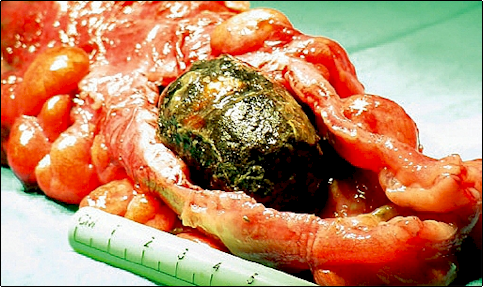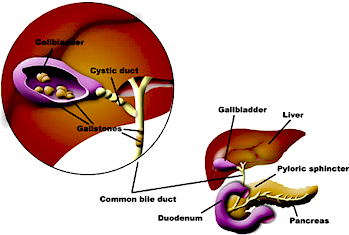About Gallstones

Gallstones are very common. About 1 in 5 people will develop gallstones during their life. (Actual lifetime risk is about 14-20% in the West) Fortunately, the vast majority( two thirds - 90%) do not cause any symptoms. Someone with gallstones have 7.6%(about a 1 in 10 chance) of developing symptoms needing hospitalization in the next 5 years. Gallstones come in all shape, number & sizes - some gallbladders are packed full of them and some have only one gallstone in it. Some gallstones are the shape of millet seeds and some are as large as a chicken egg! Some are hard and some are soft and crumbly! Some are faceted and can even look like multi-sided dice!
The gallstone story begins with the liver's production of bile, a substance used by the small intestine to digest fatty foods and aid in the absorption of certain vitamins. Bile is made in a network of tiny ducts in the liver and carried by a larger duct to the gallbladder, a small, pear-shaped organ that concentrates and stores it. When we eat, the fat in food triggers the release of a hormone that causes the gallbladder to contract and release bile into the intestine. Problems arise when the stored bile crystallizes and forms solid lumps, or gallstones.
Their size can range from as small as a grain of sand to as large as a golf ball. About 80% of gallstones are made primarily from cholesterol. The other 20% - known as pigment stones - are made of calcium salts and a substance called bilirubin, which is a breakdown product of red blood cells.
more about Gallstones...
.......
Cholesterol stones form when the liquid bile becomes supersaturated, containing more cholesterol than bile salts can dissolve. They may also develop if the gallbladder doesn't contract and empty as it should. Pigment stones are associated with certain medical conditions, including liver disease, some types of anemia, and infection of the bile ducts. Women are at a much higher risk for developing gallstone disease than men, because the female hormone estrogen increases cholesterol in the bile. As we age, the development of gallstones slows somewhat in women and increases in men. Under age 40, women are diagnosed with gallstones almost three times more often - pregnancies, for example, increase the risk - but by age 60, they have only a slightly higher incidence.

The drop-off in estrogen at menopause may be one reason. Estrogen therapy increases the risk, although the patch form of the hormone appears to cause fewer problems than oral estrogen. Obesity, especially in women, is another risk factor for gallstones, because fat tissue influences the amount of estrogen produced in the body. Rapid weight loss also increases risk; very lowcalorie diets interfere with bile production, causing more crystallization of cholesterol.



